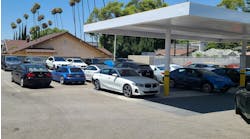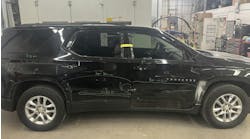Airbag deployment or other collision factors may force you to replace the IP. So do it right!
When that vehicle comes into your work bay with both of the front airbags blown, it may not be obvious at first that you will need to replace the Instrument Panel (IP). The best thing to do is refer to the service manual or your estimating software to find out if this is a required operation. There are several vehicles on the road that require the IP to be replaced after a passenger airbag deployment. When the passenger air bag deploys, it destroys the mounting area of the IP even though outer damage may not be readily visible.
Replacement procedure
We all know that there are numerous electrical items buried inside of that IP, so the first step is to write down any presets that the vehicle owner has stored for seat position, radio channels preferences, mirrors, etc. When you have the presets documented and safely stored in the repair order jacket, disconnect and isolate the battery cables per the vehicle maker’s recommendations. After waiting the recommended time, remove the driver and passenger air bag modules. Generally, the airbag deployment is the reason for replacing the IP. However, there are times when the bags may not deploy, such as a side impact in the hinge area of the A-pillar. For this reason, be certain to follow the vehicle maker’s recommendation for safely removing and storing those airbag modules.
The next step is to remove the steering column. This may require the removal of a trim panel under the IP to gain access to the bolts that hold the column to the bracing of the IP. On most vehicles there will be a u-joint connection at the firewall that will need to be disconnected. There will be a weatherproof cover that will need to be removed to gain access to that u-joint. Now go ahead and remove the fasteners that hold the column housing to the IP and rest the steering wheel on the seat. This is the time to disconnect all of the wires that go to the ignition switch, turn signals, brake switch and any cables or linkage that are there for the gear shift lever if it is mounted on the column. The wiring connectors will have lock tabs that need to be released in order to disconnect them. When you have all of the wires disconnected, then remove the bolt that holds that u-joint in place and remove the column from the vehicle.
STOP!
It is time to take a few minutes to analyze how the instrument panel and instrument cluster are held in place. A few minutes doing this now will save you a lot of time later. You should take a few minutes to look over the top of the IP and see if there are any plugs that would be covering fasteners, then look down the side (near the A-pillar) to determine if there is hardware nearly visible. The defroster air deflector may need to be removed to reveal the fasteners (Fig. 1). Finally, look at the bottom of the IP.With lots of good lighting, you are looking for bolts near the A-pillar and above the floor tunnel. If the vehicle has a console, it will most likely need to be removed to gain access to the hardware which fastens the IP to the tunnel (Fig. 2 & 3). Another area where fasteners may be located is near the passenger airbag module. If you have the service manual from the vehicle maker for the particular model you are working on, it will most likely have the location of all fasteners. The analysis time would then be spent looking for the information in the manual and comparing it to the vehicle.
Safety note: While you are doing this analysis, keep an eye open for the type of steel reinforcement used for the IP. Often they are made of stamped steel and have very sharp edges. Be certain that you are wearing your protective edquipment, namely gloves, when you start removing the IP.
GO...
Now that you have spent those precious few minutes analyzing where all the fasteners are located, start removing them. It works best if you start at the bottom, go to the sides (Fig. 4) and leave the top for last. Where those plugs were located, carefully remove them and then the fastener that was covered by the plug. I stress the word carefully because those plugs are usually in plain view of the vehicle owner and they really do not want to look at damaged plugs after they get their vehicle back. After removing all of the visible fasteners from the bottom and sides of the IP, try to move the IP with your hands. If it moves, then you have all of the fasteners removed from that portion of the IP. If it does not move, then you have not found all of the fasteners.
The stereo and/or A/C and ventilation control panel may need to be removed (Fig. 5) to gain access to additional fasteners located behind them. These may also need to be removed to gain access to disconnect the wiring from these units. The instrument cluster may need to be removed to gain access to additional fasteners for the IP. Remove the screws that retain the bezel in place (Fig. 6), gently pry the bezel from the opening (Fig. 7) and remove the bezel (Fig. 8). Then remove the screws that retain the instrument cluster in place (Fig. 9), unplug the wiring connector and remove the cluster. Often, the wiring for the instrument cluster will need to be disconnected so that the IP can be removed.
If you do remove the cluster, be sure that you store it in a clean and dry environment, as there are numerous electrical and electronic devices within the cluster an d you do not want them damaged. Next, remove the fasteners from the top of the IP (Fig. 10). There is usually a portion of the wiring harness that stays in the vehicle and a portion that goes with the IP. Look for the connector and unplug it where appropriate (Fig. 11). With those fasteners removed, you will probably need an assistant to help with the removal of the IP assembly as it is big and bulky (Fig. 12 ). Carefully remove the IP assembly through the door opening.
OK, that wasn’t so bad, was it?
With the new IP and the old unit setting side-by-side, transfer all wiring, ducts, deflectors, braces, etc. that are not on the new IP. If the new IP is primed, be sure to have the refinishing shop paint it before you transfer all of the components. Reinstall the new IP in the reverse order of removal. Be certain that you check the function of all components after you have the new IP installed and reset all of the previously recorded presets of seats, mirrors, radio, etc. It is very easy to crush a wire between the IP and its mounting tab and cause other problems!
But I think it can be repaired!
There are different types of damage that can be repaired on the Instrument Panel. As we discussed earlier, if the vehicle maker says the IP must be replaced due to air bag deployment, you have no choice but to replace it if you are doing a quality repair. Some of the more common repairs are from passenger knees striking the IP during the collision, inertia damage (when a loose object inside the vehicle strikes the IP during the collision) or when the A-pillar is pushed into the IP from a side collision. The repairs that can be made are generally of a cosmetic nature. If the structure of the IP is broken, there is usually enough damage on the outside that the IP must be replaced.
The repair process is the same as other types of plastic repairs. You will have to make the decision as to whether the repair will be made with the IP in the vehicle or removed from the vehicle. Keep in mind that if you decide to do the repair in the vehicle, the odors of the repair process may be difficult to eliminate. The vehicle owner may not appreciate the odor left behind from the repair and refinish process. You must identify the type of plastic from which the IP is made. Then make the determination of whether you will perform the repair by welding or using an adhesive/ chemical. The biggest challenge is to get the grain texture and pattern to duplicate the original surface so that you make an invisible repair.
One way to accomplish this is to place a piece of aluminum foil over an undamaged area of the IP and, using a firm roller, press the foil into the pattern. Then carefully remove the foil and set it aside. Perform the repair as you would for any plastic. When you have the final coat of adhesive/filler applied gently press the foil piece into the wet product. This will transfer the texture and grain onto the filler. Then refinish as per the directions for your refinish products.
In summary
There are certain guidelines that must be followed if you are going to consider repairing the Instrument Panel. If the damage was caused by a deployed passenger air bag, the vehicle maker may require the replacement of the IP because of damage to the air bag mounting points. If the damage is cosmetic, you may be able to repair it. The replacement procedure is somewhat detailed, but generally no more than some other vehicle components.



